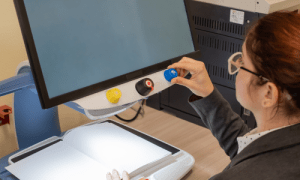Are you familiar with the phrase “equal access for all”? Unfortunately, the visually impaired community is still often left out of conversations about accessibility and inclusion. Over a decade after the Americans With Disabilities Act (ADA) was passed into law, many physical spaces are still not built to accommodate those who cannot see. However, it isn’t all bad news; in recent years there have been exciting developments in technology as well as innovative architectural solutions that break down barriers and make life easier for blind and low vision individuals. In this blog post, we’ll discuss what modern accessibility looks like for people living with visual impairments today.
Accessibility Support in Modern Technology
As technology continues to evolve, it’s important to ensure that everyone has equal access to its benefits. That’s where accessibility support comes in, providing features and tools that make technology more usable for individuals with disabilities. From screen readers and magnifiers to closed captions and alternative input methods, modern technology has come a long way in its commitment to accessibility. There is still more work to be done. By embracing accessibility as a fundamental aspect of design and development, we can continue to create inclusive and equitable experiences for all users. The power of technology lies in its ability to connect and empower individuals from diverse backgrounds, and accessibility support is critical to making that vision a reality.
Assistive Technologies for the Visually Impaired
There are numerous types of assistive technologies available for people who are visually impaired, each designed to help them navigate the world with greater ease and independence. One such technology is the screen reading software that can read out loud what is displayed on a computer screen. This technology can be a game-changer for those who rely on computers for work or school. Another popular option is the Braille display, which converts text on a screen into Braille characters that can be read using the fingers. For those who prefer audio formats, audio books, podcasts, and voice-assisted technologies can take center stage. Vision-enhancing technologies such as magnifiers can help people with low vision to read books, labels and recognize faces. These technologies serve as tools that help visually-impaired individuals accomplish more, and live life more fully.
How Assistive Technologies Help
Living with visual impairment can be difficult, but assistive technologies have revolutionized the way the visually impaired navigate the world around them. At home, these technologies can help with everyday tasks like cooking, cleaning, and even checking the weather. In the classroom, students with visual impairment can use assistive technologies to participate in various activities, such as accessing digital resources, taking notes, and even reading textbooks. In public spaces, assistive technologies like audio descriptions in museums and transportation apps make it possible for visually impaired individuals to explore the world beyond their homes. These technologies have made significant contributions to enhancing the quality of life for those with visual impairment, and their continued development and implementation are essential to further improve accessibility and inclusiveness.
Benefits of Voice-Activated Systems
Voice-activated systems are a game-changer for individuals with visual impairments. Not only does it make day-to-day tasks easier, but it also provides a newfound sense of independence. With these systems, visually impaired individuals can navigate their environments with ease and precision. As vision is no longer a requirement to operate a device, individuals with visual impairments can perform tasks they thought were once unattainable. Additionally, voice-activated systems can help with safety concerns, such as setting a timer for cooking or checking the temperature for outdoor activities. It’s not just convenience, but empowerment that comes with voice-activated systems for the visually impaired.
Tips for Creating an Inclusive Environment with Accessible Technology
In today’s world, technology has become an integral part of our lives. It’s essential that we make sure that everyone can access it equally. Creating an inclusive environment with accessible technology goes beyond just providing ramps or closed captioning. We need to have an understanding of people’s different abilities and how we can help them to navigate technology. For example, we can incorporate voice-activated tools or make sure that our designs are easily accessible for those who use screen readers. It’s important that we all work together to make technology a tool that’s open and accessible to everyone. By taking these steps towards inclusivity, we can make progress towards creating a world that is more equitable.
Strategies to Make Assistive Technologies More Accessible
As technology continues to advance, we have a responsibility to ensure that people with disabilities are not left behind. Assistive technologies, such as screen readers and speech recognition software, have the potential to greatly improve the quality of life for individuals with disabilities. However, the high cost and limited accessibility of these technologies make them out of reach for many who need them. Strategies to make assistive technologies more accessible include advocating for government funding and tax incentives for companies that make these technologies, collaborating with disability advocacy groups, and increasing public awareness about the importance of equal access to technology. By taking these steps, we can work towards a more inclusive society that benefits everyone.
In today’s world, it is so important to focus on making technology more inclusive and accessible for everyone. Accessibility support through modern technology has revolutionized the way people with disabilities interact with the world around them. Assistive technologies offer a wealth of opportunities to the visually impaired, enabling those with disabilities to engage in home, classroom, and public environments. From voice-activated systems to headphone amplification devices, there are a myriad of options available to those who are seeking extra support. It is also critical for society as a whole to create an understanding and accepting environment that allows individuals with disabilities to feel respected and included. By incorporating accessible technology into everyday life and being mindful of others’ needs, we can help promote inclusion for all.

